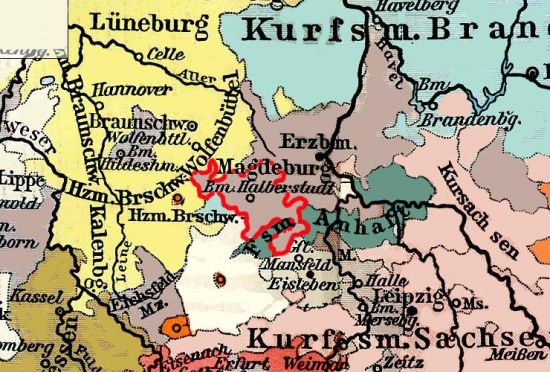Difference between revisions of "Halberstadt 1628-CZ thaler Dav-5346"
(revised bibliography) |
m (Text replacement - "from Brunswick-Wolfenbuttel" to "from Brunswick-Wolfenbüttel") |
||
| Line 2: | Line 2: | ||
[[Image:Halberstadt 1547.jpg|550px|thumb|Halberstadt in 1547]] | [[Image:Halberstadt 1547.jpg|550px|thumb|Halberstadt in 1547]] | ||
| − | The bishopric of Halberstadt was founded in the early ninth century. In 1479, a Saxon prince, greedy for the see's revenues, pushed out the reigning bishop and appointed his teenage son as administrator. No bishop was anointed to succeed him and the diocese was ruled by administrators thru the Reformation, which arrived in 1540. Various princes of the Brunswick-Wolfenbüttel family ruled 1566-1623, of which Christian was the last. The next administrator was a prince of the Hohenzollern family and the bishopric was annexed to Brandenburg by the terms of the Peace of Westphalia in 1648. It remained a part of Prussia until the end of the Wilhelmine empire. This specimen was lot 105 in Künker sale 263 (Osnabrück, June 2015), where it sold for €800 (about US$1,033 including buyer's fees). The catalog description<sup>[1]</sup> noted, <blockquote>"''Halberstadt, BISTUM Domkapitel. Reichstaler 1628. Mit einfacher Raute am Ende der Vorderseitenumschrift. R Feine Patina, sehr schön +.'' (bishopric of Halberstadt, thaler of 1628-CZ, with diamond at the end of the obverse legend. Scarce, fine patina, choice very fine.)"</blockquote> The bishop, Christian, was from Brunswick- | + | The bishopric of Halberstadt was founded in the early ninth century. In 1479, a Saxon prince, greedy for the see's revenues, pushed out the reigning bishop and appointed his teenage son as administrator. No bishop was anointed to succeed him and the diocese was ruled by administrators thru the Reformation, which arrived in 1540. Various princes of the Brunswick-Wolfenbüttel family ruled 1566-1623, of which Christian was the last. The next administrator was a prince of the Hohenzollern family and the bishopric was annexed to Brandenburg by the terms of the Peace of Westphalia in 1648. It remained a part of Prussia until the end of the Wilhelmine empire. This specimen was lot 105 in Künker sale 263 (Osnabrück, June 2015), where it sold for €800 (about US$1,033 including buyer's fees). The catalog description<sup>[1]</sup> noted, <blockquote>"''Halberstadt, BISTUM Domkapitel. Reichstaler 1628. Mit einfacher Raute am Ende der Vorderseitenumschrift. R Feine Patina, sehr schön +.'' (bishopric of Halberstadt, thaler of 1628-CZ, with diamond at the end of the obverse legend. Scarce, fine patina, choice very fine.)"</blockquote> The bishop, Christian, was from Brunswick-Wolfenbüttel but never ruled as duke there. This scarce type is slightly less rare than other issues of the 1620's. |
''Recorded mintage:'' unknown. | ''Recorded mintage:'' unknown. | ||
Revision as of 15:14, 14 September 2025
The bishopric of Halberstadt was founded in the early ninth century. In 1479, a Saxon prince, greedy for the see's revenues, pushed out the reigning bishop and appointed his teenage son as administrator. No bishop was anointed to succeed him and the diocese was ruled by administrators thru the Reformation, which arrived in 1540. Various princes of the Brunswick-Wolfenbüttel family ruled 1566-1623, of which Christian was the last. The next administrator was a prince of the Hohenzollern family and the bishopric was annexed to Brandenburg by the terms of the Peace of Westphalia in 1648. It remained a part of Prussia until the end of the Wilhelmine empire. This specimen was lot 105 in Künker sale 263 (Osnabrück, June 2015), where it sold for €800 (about US$1,033 including buyer's fees). The catalog description[1] noted,
"Halberstadt, BISTUM Domkapitel. Reichstaler 1628. Mit einfacher Raute am Ende der Vorderseitenumschrift. R Feine Patina, sehr schön +. (bishopric of Halberstadt, thaler of 1628-CZ, with diamond at the end of the obverse legend. Scarce, fine patina, choice very fine.)"
The bishop, Christian, was from Brunswick-Wolfenbüttel but never ruled as duke there. This scarce type is slightly less rare than other issues of the 1620's.
Recorded mintage: unknown.
Specification: silver.
Catalog reference: Besser/Brämer/Bürger 45.55; Dav-5346, KM 56.1.
- Cuhaj, George S., and Thomas Michael, Standard Catalog of World Coins, 1601-1700, 6th ed., Iola, WI: Krause Publications, 2014.
- Davenport, John S., German Church and City Talers, 1600-1700, Galesburg, IL, 1967.
- [1]Künker Münzauktionen und Goldhandel, Catalog 263, The Friedrich Popken collection of gold and silver coinages | Coins and Medals from Medieval and Modern Times, a. o. the collection of Ernst Otto Horn, part III, Osnabrück: Fritz Rudolf Künker GmbH & Co., AG, 2015.
Link to:

